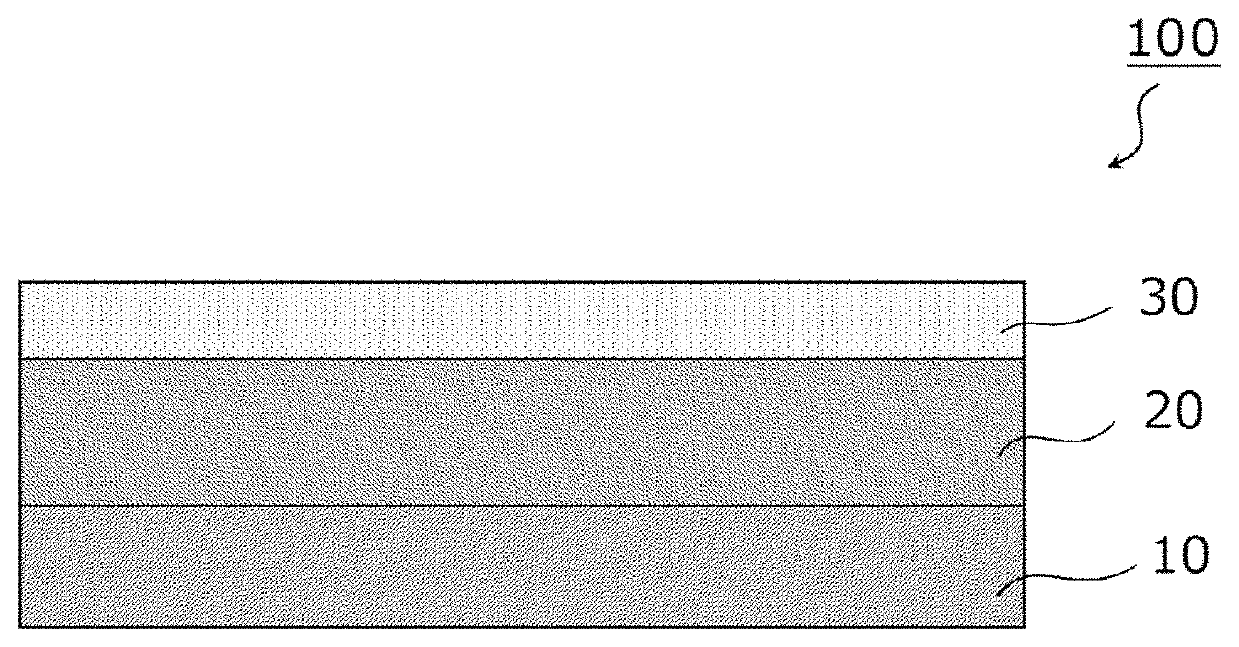Pressure-sensitive adhesive tape for protecting semiconductor
a technology of pressure-sensitive adhesives and adhesive tapes, which is applied in the direction of film/foil adhesive primer layers, film/foil adhesives, transportation and packaging, etc., can solve the problems of melting of thermoplastic pressure-sensitive adhesives due to grinding heat and adhesive residue after peeling
- Summary
- Abstract
- Description
- Claims
- Application Information
AI Technical Summary
Benefits of technology
Problems solved by technology
Method used
Image
Examples
example 1
[0083]A composition for forming an intermediate layer containing 100 parts by weight of an acrylic polymer including ethyl acrylate (EA), butyl acrylate (BA), and acrylic acid (AA) at a weight ratio of 50 / 50 / 5, 1 part by weight of a polyisocyanate compound (product name: “CORONATE L”, manufactured by Tosoh Corporation), 10 parts by weight of a UV oligomer (product name: “ARONIX M321”, manufactured by Toagosei Co., Ltd.), 3 parts by weight of a photopolymerization initiator (product name: “OMNIRAD 651”, manufactured by IGM Resins B.V.), and toluene was prepared. The composition was applied to the base material having a thickness of 50 μm (PET film, manufactured by Toray Industries, Inc., product name: “LUMIRROR 5105”), and was then heated at 120° C. for 120 seconds so that the solvent was removed therefrom. Thus, an intermediate layer having a thickness of 150 μm was formed.
[0084]Meanwhile, 11 mol of hydroxyethyl acrylate (HEA) of an acrylic polymer including 2-ethylhexyl acrylate (2...
example 2
[0087]A composition for forming an intermediate layer containing 100 parts by weight of an acrylic polymer including ethyl acrylate (EA), butyl acrylate (BA), and acrylic acid (AA) at a weight ratio of 50 / 50 / 5, 3 parts by weight of a photopolymerization initiator (product name: “OMNIRAD 651”, manufactured by IGM Resins B.V.), 1 part by weight of a polyisocyanate compound (product name: “CORONATE L”, manufactured by Tosoh Corporation), and toluene was prepared. The composition for forming the intermediate layer was applied to the base material having a thickness of 50 μm (PET film, manufactured by Toray Industries, Inc., product name: “LUMIRROR S105”), and was then heated at 120° C. for 120 seconds so that the solvent was removed therefrom. Thus, an intermediate layer having a thickness of 150 μm was formed.
[0088]Meanwhile, 11 mol of hydroxyethyl acrylate (HEA) of an acrylic polymer including 2-ethylhexyl acrylate (2-EHA), acryloylmorpholine, and HEA at a molar ratio of 75 / 25 / 22 was ...
PUM
| Property | Measurement | Unit |
|---|---|---|
| storage modulus | aaaaa | aaaaa |
| diameter | aaaaa | aaaaa |
| thickness | aaaaa | aaaaa |
Abstract
Description
Claims
Application Information
 Login to View More
Login to View More - R&D
- Intellectual Property
- Life Sciences
- Materials
- Tech Scout
- Unparalleled Data Quality
- Higher Quality Content
- 60% Fewer Hallucinations
Browse by: Latest US Patents, China's latest patents, Technical Efficacy Thesaurus, Application Domain, Technology Topic, Popular Technical Reports.
© 2025 PatSnap. All rights reserved.Legal|Privacy policy|Modern Slavery Act Transparency Statement|Sitemap|About US| Contact US: help@patsnap.com

